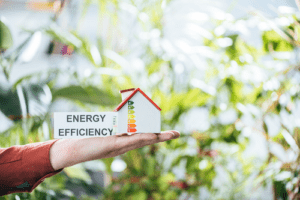When you’re considering investing in an air conditioning system, there are many factors to weigh. How much does it cost? What kind of new construction or installation does it involve? Which environmental factors impact your air conditioner options? Each of these concerns are critical, and it only takes a bit of research to make your next steps more clear.
Some considerations require professional attention. One of those considerations is how to calculate EER, or “Energy Efficiency Ratio”. This calculation is particularly helpful for those who are looking to cool larger buildings or must regularly deal with extreme temperature and humidity conditions. We explain what EER is, how to calculate it, how to use it to your advantage, and the best sources to turn to for efficiency assistance.
Introduction to Measuring Air Conditioner Efficiency
 When you’re trying to figure out how efficient a conditioning system will be, you need to know two pieces of information: interior dimensions and exterior conditions. Your interior dimensions include the size of your building, what kind of airflow is present between rooms, and how much flow there is between the inside and outside (such as through entryways and windows or due to insulation). Exterior conditions include seasonal weather patterns, humidity, and the average temperature range.
When you’re trying to figure out how efficient a conditioning system will be, you need to know two pieces of information: interior dimensions and exterior conditions. Your interior dimensions include the size of your building, what kind of airflow is present between rooms, and how much flow there is between the inside and outside (such as through entryways and windows or due to insulation). Exterior conditions include seasonal weather patterns, humidity, and the average temperature range.
The Best Methods to Use to Calculate EER
EER uses base conditions of 90 degrees Fahrenheit outside, 90 degrees inside, and 50% humidity. Even though your actual conditions will vary, these standards form the standard of comparison between models when you calculate EER.
There’s another way to derive helpful information from EER: SEER. “Seasonal Energy Efficiency Ratio” is particularly helpful in climates that don’t closely match the conditions that contribute to EER. Most manufacturers must display this information, so when you’re purchasing a new air conditioner, you can get this information directly from the manual or from other pieces of technical information provided with each air conditioner.
Putting These Calculations to Work for You
How can you use EER and SEER to make stronger decisions while purchasing a new air conditioner?
- Research the common climate conditions around your building. Regarding nearby locations, several miles can make a significant difference, especially if there’s a change in altitude or the presence of geographical features such as mountains, forests, or rivers. These features have a significant impact on humidity and can also influence the temperature fluctuation. For example, in areas closer to deserts, the temperature is more likely to vary significantly between night and day.
- If conditions often match EER measurements during the summer when you’re more likely to use the air conditioner, then pay close attention to those numbers. If your local conditions don’t meet those standards very often, then give additional weight to the SEER.
- Don’t rely exclusively on EER or SEER when searching for an air conditioner for your building. You may already have ductwork in your building that’s suited to a lower EER or in a poor location for more efficient systems. In those cases, the ancillary costs will often outweigh the system’s efficiency. When you use EER and SEER, you can make an informed decision that will minimize your costs without sacrificing comfort.
Generally, the higher your EER or SEER, the cheaper the system will be in the long run. You may find high EERs on renewable systems such as solar-powered heat pumps. Geothermal heating systems also take advantage of natural energy to provide efficient cooling for a building.
Recognize that such systems are often significantly more expensive to install initially. Don’t close yourself off to any solution if you’re most interested in saving money. If your primary concern is limiting your environmental impact and cooling more sustainably, then you will likely want to follow EER and SEER ratings more closely.
Finding a Qualified Technician to Calculate EER for Your Building
When you’re considering new systems, it’s vital to take stock of what you want out of an air conditioner. Determine your priorities, whether you want the most powerful system, the most sustainable system, or the most efficient system available. In any of these cases, calculate EER so that you have essential, objective information on hand with which to make your decision.
Most people are too busy to perform this research personally. If that describes your situation, you can rely on a trustworthy HVAC contractor to let you know what to expect. Locate a contractor that has a positive reputation among homeowners and businesses in your area, which suggests that they will deliver high-quality service and provide helpful information with which their clients can make informed decisions.
Ultimately, you make the call regarding how you’d like to cool your building. You deserve the most accurate information available, so don’t hesitate to turn to a licensed professional who is willing to offer you the full benefit of their experience.

